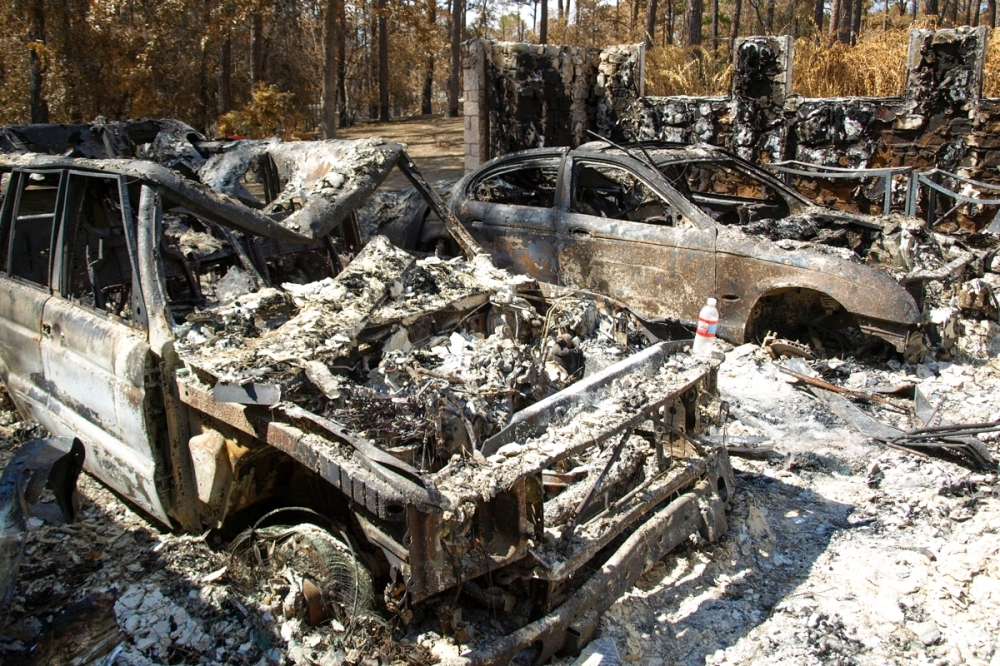The 2011 fire—three individual fires that combined and were later named the Bastrop County Complex Fire—remains the most destructive in Texas history, according to the Texas A&M Forest Service.
Thirteen years later, the county has increased its ability to communicate with residents ahead of an emergency, created a local fire response task force and helped resident reduce wildfire risk on their property. However, other challenges identified during the 2011 fire and before, such as lack of exits for some neighborhoods, remain a challenge.
“I will always have a fear that another fire could happen,” Cox said. “We’ve had a couple of scares since the Complex Fire.”
Though wildfires typically occur during the later months of summer, the Bastrop County Office of Emergency Management is ramping up its public education campaign now to help residents prepare.
Two-minute impact
Central Texas does not have a set wildfire season, but historically Bastrop County has faced the most significant fires in January and February, and from August to October, said Wade Powell, wildland fire management specialist for the Texas Parks & Wildlife Department.
The region is likely to see a normal fire season—meaning, there will be fires—but it’s unlikely to be an extreme season, said Luke Kanclerz, Texas A&M Forest Service predictive service department head.
The wildfire risk increases in late summer as vegetation dries out and it becomes easier for fires to start and spread, Kanclerz said. As of press time, Bastrop County is not in a drought, but Kanclerz expects to see vegetation start to dry out when Central Texas experiences extreme summer heat.
“As conditions become warm and dry whatever [residents] can do to reduce accidental ignition, that’ll go a long way to protecting the citizens of Bastrop County,” Kanclerz said.
Almost all wildfires, 90%, are caused by humans, according to the TPWD.
The Bastrop area has historically faced large and difficult-to-control fires due to the dense pine, yaupon and juniper trees in the area, which act as fuel for fires, Kanclerz said.
While fires are expected to burn in Bastrop County and throughout parts of Texas, local and state officials are prioritizing public lands resilience and hardening homes against wildfire risk.
Many Bastrop residents are more aware of fire danger and better prepared than in 2011, said Sheila Lowe, executive director of the Bastrop County Long Term Recovery Team. The organization formed after the 2011 fire, and aids low-income and uninsured or underinsured residents in recovering from long-term disasters.
“Because of the destruction the fire caused and the amount of time it took to recover, it stayed on everyone’s mind and in our faces,” Lowe said. “We never want to be those victims again.”
Zooming in
In 2011, Cox’s home was one of 1,673 destroyed, according to the TPWD. The fire’s path also included 96% of Bastrop State Park, per TPWD.
Cox said she thinks emergency responders did the best they could notifying residents and combating the fire.
“Mother Nature gave us perfect fire conditions with a long drought and extremely windy conditions,” Cox said.
Despite her experience, Cox chose to rebuild in the neighborhood. Cox and her family planted new pine trees that are growing along with other vegetation.

The big picture
There are several factors that contribute to the severity of a wildfire season, said Kari
Hines, resources protection specialist for the Texas A&M Forest Service.
Small fires that control vegetation are part of maintaining a healthy landscape, Hines said. But more than 150 years ago, the United States began extinguishing these fires. As the planet warms and thus dries, people alter the landscape through development and brush is left to build up, wildfire danger increases, O’Connor said.
Just over 87% of Bastrop residents live in a Wildland Urban Interface area, according to a 2022 report from the county. WUI are places where developments meet open grasslands where wildfires are most likely to occur.
From 2005-2020, about 2,000 fires occurred in Bastrop County, according to the report.
A 2008 report from the most recent specifically on wildfires—found the county faces multiple challenges with wildfire response.
The 2008 report identified several concerns for wildfire management within the county, including lack of homeowner education about mitigation, lack of firefighting resources, development patterns, and inadequate emergency access and exits in neighborhoods.
Three years ago, the firefighting departments throughout Bastrop County—including Emergency Services Departments 1 and 2, the Smithville Fire Department and more—formed a task force. This group activates during periods of high wildfire risk, said James Altgelt, emergency management coordinator for the BCOEM. The departments take shifts during this time to keep firefighting resources on standby and dedicated to only wildfire responses. Altgelt said this has been instrumental in ensuring adequate resources reach fires early.
One concern was that more than 70 neighborhoods lacked adequate evacuation entrances and exits or had other issues, such as lack of space to turn around. Altgelt said that number has grown since the report.
Since the 2011 fire, Bastrop County built another exit route from Tahitian Village, a large neighborhood that experienced a high volume of traffic during that emergency. The process was costly, took years and required using eminent domain laws to get the property, Altgelt said, which are indicators of challenges the county would face in trying to address similar issues in other neighborhoods.
Altgelt said, for example, the county applied for a multimillion-dollar federal grant to build another bridge over the Colorado River to increase emergency routes, but the county did not receive the grant.
What’s next
Going forward, Altgelt said the county is exploring ways to address current needs for emergency routes and considering development code updates to set certain requirements for entrances/exits.••Both the county and the state are also looking to mitigate future risk by caring for the land.
At the county level, Altgelt said there is a program where the county uses grant money to help property owners create fire breaks on their properties and clean up any extraneous fuel, which the property owner agrees to maintain.
The A&M Forest Service and other state agencies—including the Texas Parks and Wildlife Department and the Lower Colorado River Authority—are working to restore government lands on the Bastrop State Park, Camp Swift and LCRA land to a more resilient landscape, such as reducing excess fuels.
“The people who are out there doing this land management are extremely passionate about trying to do the best thing possible not just for fire risk reduction but for habitat creation and drought resiliency ... and community protection comes with that,” Hines said.
In the event of a future fire, Altgelt said residents will be notified through social media and emergency notification systems, such as Warn Central Texas. In an evacuation, first responders would go door-to-door to notify residents. The county can also send push notifications similar to Amber Alerts and send messages over the National Weather Service radio.
“Although the [2011] wildfire was a difficult time for our family, the outpouring of love and support from the community was overwhelming. ... Bastrop truly became our home,” Cox said.
According to the Texas A&M Forest Service, residents can prepare their homes by:
- Cleaning roofs and gutters
- Repairing/replacing missing roof tiles and broken window screens
- Installing mesh in exterior vents to prevent embers from entering
- Moving any flammable material away from wall exteriors, such as mulch, flammable plants and firewood piles
- Creating fuel breaks with driveways, walkways and paths, patios and decks, and space between clumps of vegetation
- Keeping lawns mowed to a height of 4 inches
- Removing vegetation under trees as well as removing dead plants and trees






